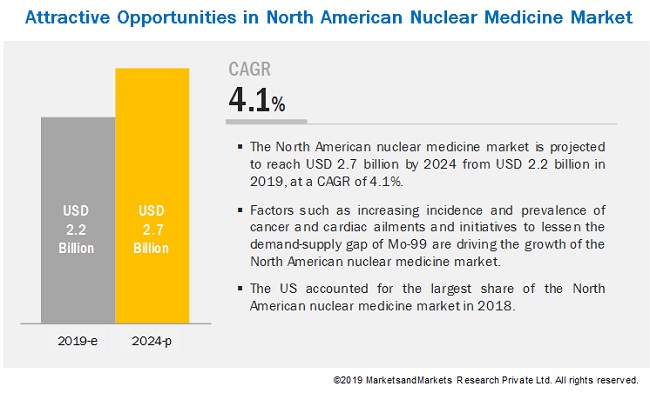Growth in the market can primarily be attributed to factors such as the increasing incidence and prevalence of cancer & cardiac ailments and initiatives to lessen the demand-supply gap of Mo-99. However, the short half-life of radiopharmaceuticals reduces their potential adoption, while hospital budget cuts and high equipment prices are expected to limit market growth to a certain extent.
The North American nuclear medicine market is expected to reach USD 2.7 billion by 2024 from an estimated USD 2.2 billion in 2019, growing at a CAGR of 4.1% during the forecast period.

The growth of the market can be attributed to increasing drug discovery activities, the growing biopharmaceutical industry, and the rising trend in outsourcing compound/sample management. The rising drug discovery activity is leading to an increased demand for compounds, which is positively affecting market growth.
Download PDF Brochure: https://www.marketsandmarkets.com/pdfdownloadNew.asp?id=1108
Based on type, the market is categorized into diagnostic and therapeutic nuclear medicine. The therapeutic nuclear medicine segment is further segmented into alpha emitters, beta emitters, and brachytherapy isotopes. In 2013, the FDA approved the first and only product for alpha emitters in the market, launched by Bayer AG under the name Xofigo (a Ra-223 dichloride molecule). The North American market for Ra-223 is expected to command the largest share owing to its targeted properties over beta emitters and being the only alpha-emitter product available in the market.
Based on application, the North American nuclear medicine market is segmented into SPECT, PET, and therapeutic applications. The SPECT applications segment is further segmented into cardiology, bone scans, thyroid applications, pulmonary scans, and other SPECT applications. The thyroid applications segment is projected to register the highest growth rate in the forecast period. The high growth of this segment can be attributed to the increasing incidence and prevalence of thyroid disorders.
Based on procedural volume assessment, the market is segmented into SPECT, PET, and therapeutic procedures. The PET procedural volume segment by type is further segmented into F-18, Ru-82, and other PET Isotopes. The F-18 segment is expected to account for the largest share of the PET procedural volume assessment in 2019. The large share of this segment can be attributed to the increasing use of F-18 in diagnostic PET applications.
The geographical regions mapped in the report are:
Geographically, the North American market comprises of US and Canada. In 2018, the US accounted for the largest share of the nuclear medicine market. The large share can be attributed to the development of novel technologies for radioisotope production, government funding, and company initiatives in the country.
Request Sample Pages: https://www.marketsandmarkets.com/requestsampleNew.asp?id=1108
Some key players mentioned in the research report are:
Cardinal Health (US), GE Healthcare (US), Curium (France), Lantheus Medical Imaging (US), Bayer AG (Germany), Bracco Imaging (Italy), Eczacýbaþý-Monrol Nuclear Products (Turkey), Nordion (Canada), Advanced Accelerator Applications (France), and NTP Radioisotopes (South Africa).


